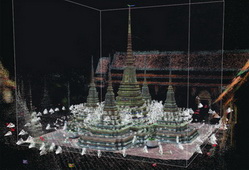Documenting Glazed-Tile Architecture for Conservation: The Case of Five Chedis built on a Single Continuous Base, Wat Phra Chetuphon Wimon Mangkhalaram Rajwaramahawihan
Main Article Content
Abstract
This research aims to propose a suitable technique for documenting historic buildings using the chedis at Wat Phra Chetuphon Wimon Mangkhalaram Rajwaramahawihan, which are built as a series of five structures on a single continuous base, as a case study. The research's primary data sets are gathered from nine temples and organized in five subjects: (1) materials used; (2) characteristics and types of decorative glazed tiles; (3) architectural works decorated with glazed tiles; (4) level of deterioration; (5) conservation techniques for glazed tiles. They are used for analysis and created Data Collection Set together with documentary research, field study, and building deterioration assessments.
Using this methodological approach for the case study of the Five Chedis leads to the following findings: (1) Photogrammetry helps to reduce inaccuracies in architectural drawings; (2) Data sets allow researchers to more easily evaluate the outstanding characteristics of case studies by comparing them with basic characteristics and, therefore, more accurately define the significance of heritage buildings; (3) Architectural drawings are a useful base for inserting data according to the given variables of the data set, including types of materials, level of deterioration of materials and overall structure, and identification of the age of materials and their authenticity. This methodological approach is useful for examining the shape of tiles, how to cut the tiles from the bowls, and the deterioration of materials. This Data Collection Set offers an example of how to collect and analyze wide-ranging data before choosing a conservation method and also an instance of how modern technology may be used to create digital drawings for better field data analysis.
Downloads
Article Details

This work is licensed under a Creative Commons Attribution-NonCommercial-NoDerivatives 4.0 International License.
References
Australia ICOMOS. Practice Note Understanding and Assessing Cultural Significance. Accessed 8 March 2023. Available from https://australia.icomos.org/wp-content/uploads/Practice-Note_Understanding-and-assessing-cultural-significance.pdf
Clergy of Wat Phra Chetuphon. Prachoomjaruekwatphrachētuphon [Corpus of Wat Phra Chetuphon Inscriptions]. 7th ed. Bangkok: Amarin Printing and Publishing Public Company Limited, 2011.
Feilden, Bernard M. Conservation of Historic Buildings. 3rd ed. Oxford: Architectural Press, 2003.
Grimmer, Anne E. The Secretary of the Interior’s Standards for the Treatment of Historic Properties with Guidelines for Preserving, Rehabilitating, Restoring & Reconstructing Historic Buildings. Washington, D.C.: U.S. Department of Interior, 2017.
Historic England. Understanding Historic Buildings A Guide to Good Recording Practice. London: Historic England, 2016.
“Ngān būrana phra mahā čhēdī pračham ratchakān thī nưng, sō̜ng, sām læ sī wat phra chē tu phon wi mon mang kha lā rām sipkāo kō̜ . phō̜ . sō̜ngphanhārō̜isāmsip - yīsipkāo mī . khō̜ . sō̜ngphanhārō̜isāmsipsām [Restoration of Phra Maha Chedi of King Rama 1, 2, 3 and 4 Wat Phra Chetupon Wimon Mangkhalaram 19 February 1987 – 29 March 1990].” 1987-1990. Ministry of Education’s Document. (4) Sor Tor. 2.3.10/7. National Archives of Thailand.
Office of Archaeology, Fine Arts Department. Kānbūrana phraprāng watʻarunrātchawarārām Rātchawō̜ramahāwihān [Restoration of Prang Wat Arun Ratchawararam Ratchawaramahawihan]. Bangkok: Office of Archaeology, Fine Arts Department, 2019.
Pinraj Khanjanusthith. Kānʻanurak mō̜radok thāng sathāpattayakam læ chumchon [Conservation Architectural Heritage and Community]. Bangkok: Chulalongkorn University Press, 2009.
Santi Pakdeekham, Chatri Prakitnonthakan and Peerapat Sumran. Sa thā pat wat phō [Architecture of Wat Pho]. Bangkok: Amarin Printing and Publishing Public Company Limited, 2009.
Somchart Chungsiriarak. “Kān bū ra na sathāpattayakam pradap krabư̄ang khlư̄ap wat phra chē tu phon wi mon mang kha lā rām rawāng Phō̜.Sō̜. sō̜ngphanhārō̜iyīsipsō̜ng - sō̜ngphanhārō̜isāmsiphā [The Restoration of the Edifices Adorned with Mosaic Tiles at Wat Phra Chetuphon from 1979-1992].” Muang Boran 18, 2 (April-June 1992): 40-61.
Somchart Chungsiriarak. Prawat nǣokhit thritsadī læ kānpatibatkān nai kānʻanurak bōrānnasathān [History, Concepts, Theories and Practices of Historic Building Conservation]. 2nd ed. Bangkok: Department of Architecture and Related Art, Faculty of Architecture, Silpakorn University, 2017.
Thanakorn Wasanapiarnpong and Karn Serivalsatit. Sē rā mik watthudip lǣng rǣ kānphalit læ kānchai ngān [Ceramics: Raw Materials Occurrence, Preparation, and Utilization]. Bangkok: MisterKopy (Thailand) Co., Ltd., 2010.
The WBDG Historic Preservation Subcommittee. Apply The Preservation Process Successfully. Accessed March 8, 2023. Available from https://www.wbdg.org/design-objectives/historic-preservation/apply-preservation-process-successfully
Watt, David S. Building Pathology Principles and Practice. 2nd ed. Oxford: Blackwell Publishing Ltd., 2007.
Wimonrart Issarathumnoon. “Initial and Planning Stages in Preservation Process, Contributions to Recommendation for Appropriate Conservation Treatments: A Case of Conservation of the Our Lady of the Rosary Church Project.” NAJUA: Architecture, Design and Built Environment 33 (January-December 2018): B3-B21.


